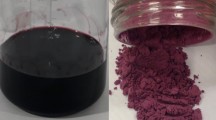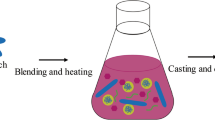Abstract
A novel gradient temperature-elevating Maillard reaction was developed to effectively produce light-colored MRPs. The main purpose of the present study was to compare the color, taste characteristic, non-volatile compounds, volatile compounds and antioxidant activity of MRPs prepared by the novel gradient temperature-elevating and traditional isothermal methods. The product prepared from soybean peptide, D-xylose and L-cysteine by gradient temperature-elevating method was termed MRP-60. Isothermal method was used to produce light and dark colored MRP, called PXC and PX, respectively. MRP-60 has not only the lowest brown intensity (A420, 0.088), also the highest overall acceptability taste from sensory evaluation. MRP-60 showed the lowest bitterness which could be attributed to the lowest content of bitter amino acids (1.48 mg/ml); MRP-60 also showed indistinctive mouthfulness compared with PXC which elucidated by the percentage of compounds with a molecular weight of 1,000–5,000 Da (15.03 %) and high antioxidant activity. Then, the MRPs prepared by gradient temperature-elevating method successfully attain desirable taste and high antioxidant activity.





Similar content being viewed by others
References
Aguiló-Aguayo I, Soliva-Fortuny R, Martín-Belloso O (2009) Avoiding non-enzymatic browning by high-intensity pulsed electric fields in strawberry, tomato and watermelon juices. J Food Eng 92(1):37–43. doi:10.1016/j.jfoodeng.2008.10.017
Amarowicz R (2009) Antioxidant activity of Maillard reaction products. Eur J Lipid Sci Technol 111(2):109–111. doi:10.1002/ejlt.200900011
Benjakul S, Visessanguan W, Phongkanpai V, Tanaka M (2005) Antioxidative activity of caramelisation products and their preventive effect on lipid oxidation in fish mince. Food Chem 90:231–239
Charurin P, Ames JM, del Castillo MD (2002) Antioxidant activity of coffee model systems. J Agric Food Chem 50(13):3751–3756. doi:10.1021/jf011703i
Delgado-Andrade C, Rufian-Henares JA, Morales FJ (2005) Assessing the antioxidant activity of melanoidins from coffee brews by different antioxidant methods. J Agric Food Chem 53(20):7832–7836. doi:10.1021/jf0512353
Dittrich R, El-massry F, Kunz K, Rinaldi F, Peich CC, Beckmann MW, Pischetsrieder M (2003) Maillard reaction products inhibit oxidation of human low-density lipoproteins in vitro. J Agric Food Chem 51(13):3900–3904. doi:10.1021/jf026172s
Eichner K (1981) Antioxidative effect of Maillard reaction intermediates. Prog Food Nutr Sci 5:441–451
Eiserich J, Shibamoto T (1994) Sulfur-containing heterocyclic compounds with antioxidative activity formed in maillard reaction model systems. In: Sulfur compounds in foods, vol 564. ACS Symposium Series, vol 564. American Chemical Society, pp 247–257. doi:10.1021/bk-1994-0564.ch020
Fekkes D, van Dalen A, Edelman M, Voskuilen A (1995) Validation of the determination of amino acids in plasma by high-performance liquid chromatography using automated pre-column derivatization with o-phthaldialdehyde. J Chromatogr B Biomed Appl 669(2):177–186
Gomyo T, Horikoshi M (1976) On the interaction of melanoidins with metallic ions. Agric Biol Chem 40:33–40
Gu F, Kim JM, Hayat K, Xia S, Feng B, Zhang X (2009) Characteristics and antioxidant activity of ultrafiltrated Maillard reaction products from a casein–glucose model system. Food Chem 117(1):48–54. doi:10.1016/j.foodchem.2009.03.074
Guan Y-G, Lin H, Han Z, Wang J, Yu S-J, Zeng X-A, Liu Y-Y, Xu C-H, Sun W-W (2010) Effects of pulsed electric field treatment on a bovine serum albumin–dextran model system, a means of promoting the Maillard reaction. Food Chem 123(2):275–280
Hidalgo FJ, Zamora R (2005) Interplay between the Maillard reaction and lipid peroxidation in biochemical systems. Ann N Y Acad Sci 1043:319–326
Huang M, Liu P, Song S, Zhang X, Hayat K, Xia S, Jia C, Gu F (2011) Contribution of sulfur-containing compounds to the colour-inhibiting effect and improved antioxidant activity of Maillard reaction products of soybean protein hydrolysates. J Sci Food Agric 91(4):710–720
Huang M, Zhang X, Eric K, Abbas S, Hayat K, Liu P, Song S, Xia S, Jia C (2012) Inhibiting the color formation by gradient temperature-elevating Maillard reaction of soybean peptide-xylose system based on interaction of L-cysteine and Amadori compounds. J Pept Sci 18(5):342–349
Hwang J-Y, Shue Y-S, Chang H-M (2001) Antioxidative activity of roasted and defatted peanut kernels. Food Res Int 34(7):639–647
Ibarz A, Pagan J, Garza S (1999) Kinetic models for colour changes in pear puree during heating at relatively high temperatures. J Food Eng 39:415–422
Jing H, Kitts DD (2002) Chemical and biochemical properties of casein-sugar Maillard reaction products. Food Chem Toxicol 40(7):1007–1015
Kang Z, Li H, Li G, Yin D (2006) Reaction of pyridoxamine with malondialdehyde: mechanism of inhibition of formation of advanced lipoxidation end-products. Amino Acids 30(1):55–61. doi:10.1007/s00726-005-0209-6
Karangwa E, Khizar H, Rao L, Nshimiyimana DS, Foh MBK, Li L (2010) Optimization of processing parameters for clarification of blended carrot-orange juice and improvement of its carotene content. Adv J Food Sci Technol 2(5):268–278
Kim J-S, Lee Y-S (2009) Antioxidant activity of Maillard reaction products derived from aqueous glucose/glycine, diglycine, and triglycine model systems as a function of heating time. Food Chem 116(1):227–232. doi:10.1016/j.foodchem.2009.02.038
Lan X, Liu P, Xia S, Jia C, Mukunzi D, Zhang X, Xia W, Tian H, Xiao Z (2010) Temperature effect on the non-volatile compounds of Maillard reaction products derived from xylose–soybean peptide system: further insights into thermal degradation and cross-linking. Food Chem 120(4):967–972. doi:10.1016/j.foodchem.2009.11.033
Lingnert H (1980) Antioxidative Maillard reaction producutes III. Application in cookies. J Food Process Preserv 4(4):219–233. doi:10.1111/j.1745-4549.1980.tb00608.x
Liu P, Huang M, Song S, Hayat K, Zhang X, Xia S, Jia C (2010) Sensory characteristics and antioxidant activities of Maillard reaction products from soy protein hydrolysates with different molecular weight distribution. Food Bioprocess Technol. doi:10.1007/s11947-010-0440-3
Morales FJ, Jiménez-Pérez S (2001) Free radical scavenging capacity of Maillard reaction products as related to colour and fluorescence. Food Chem 72(1):119–125
Mulder H (1952) Taste and flavour-forming substances in cheese. Neth Milk Dairy J 6:157–167
Ogasawara M, Katsumata T, Egi M (2006a) Taste properties of Maillard-reaction products prepared from 1000 to 5000 Da peptide. Food Chem 99(3):600–604
Ogasawara M, Yamada Y, Egi M (2006b) Taste enhancer from the long-term ripening of miso (soybean paste). Food Chem 99(4):736–741. doi:10.1016/j.foodchem.2005.08.051
Oyaizu M (1988) Antioxidative activities of browning products of glucosamine fractionated by organic solvent and thin-layer chromatography. J Jpn Soc Food Sci Technol 35(11):771–775
Rao L, Hayat K, Lv Y, Karangwa E, Xia S, Jia C, Zhong F, Zhang X (2011) Effect of ultrafiltration and fining adsorbents on the clarification of green tea. J Food Eng 102(4):321–326
Rufián-Henares JA, Morales FJ (2007a) Effect of in vitro enzymatic digestion on antioxidant activity of coffee melanoidins and fractions J. Agric Food Chem 55:10016–10021
Rufián-Henares JA, Morales FJ (2007b) Angiotensin-I converting enzyme inhibitory activity of coffee melanoidins. J Agric Food Chem 55(4):1480–1485
Shon M-Y, Kim T-H, Sung N-J (2003) Antioxidants and free radical scavenging activity of Phellinus baumii (Phellinus of Hymenochaetaceae) extracts. Food Chem 82(4):593–597
Solms J (1969) Taste of amino acids, peptides, and proteins. J Agric Food Chem 17(4):686–688. doi:10.1021/jf60164a016
Wagner KH, Derkits S, Herr M, Schuh W, Elmadfa I (2002) Antioxidative potential of melanoidins isolated from a roasted glucose–glycine model. Food Chem 78(3):375–382. doi:10.1016/s0308-8146(02)00200-5
Wijewickreme AN, Kitts DD, Durance TD (1997) Reaction conditions influence the elementary composition and metal chelating affinity of nondialyzable model Maillard reaction products. J Agric Food Chem 45(12):4577–4583. doi:10.1021/jf970041n
Yamaguchi N, Koyama Y, Fujimaki M (1981) Fractionation and antioxidative activity of browning reaction products between D-xylose and glycine. Prog Food Nutr Sci 5:429–439
Yang BG, Liu SC (1983) Studies on the bitterness of protein. Food Science 12:1–2
Yen G, Hsieh P (1995) Antioxidative activity and scavenging effects on active oxygen of xylose–lysine Maillard reaction products. J Sci Food Agric 67:415–420
Yoshimura Y, Lijima T, Watanabe T, Nakazawa H (1997) Antioxidative effect of Maillard reaction products using glucose−glycine model system. J Agric Food Chem 45(10):4106–4109
Acknowledgments
The research was supported in part by National Natural Science Foundation of China 31071602, Innovation Fund for Technology Based Firms 10C26213200976 and Agricultural science and technology achievements transformation project 2011GB23600012.
Author information
Authors and Affiliations
Corresponding author
Rights and permissions
About this article
Cite this article
Huang, M., Zhang, X. & Karangwa, E. Comparation sensory characteristic, non-volatile compounds, volatile compounds and antioxidant activity of MRPs by novel gradient temperature-elevating and traditional isothermal methods. J Food Sci Technol 52, 858–866 (2015). https://doi.org/10.1007/s13197-013-1083-y
Revised:
Accepted:
Published:
Issue Date:
DOI: https://doi.org/10.1007/s13197-013-1083-y




